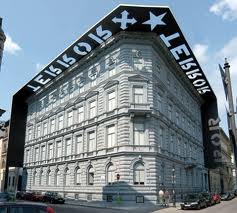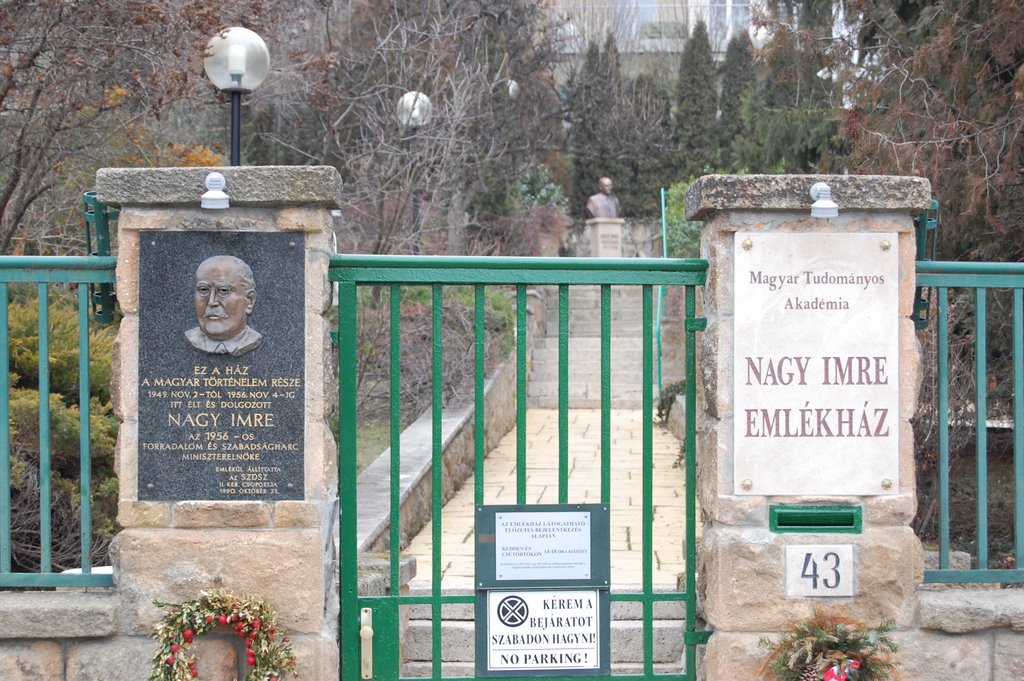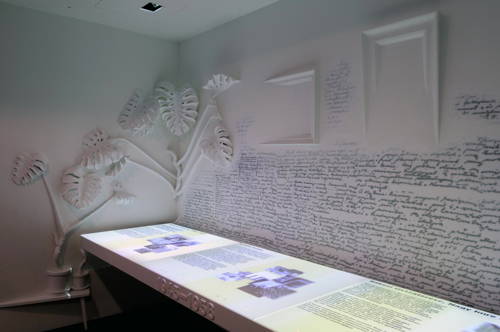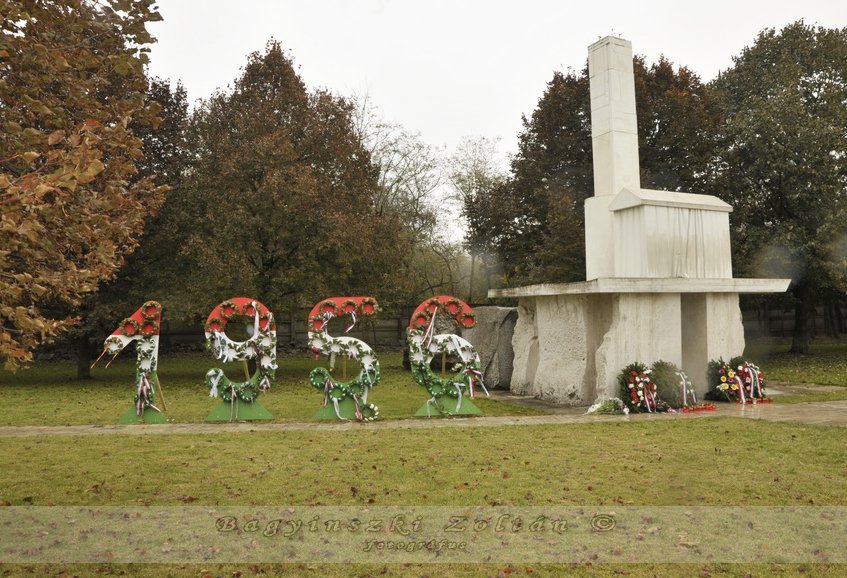
В этот день перед музеем было много народа. Мы долго ждали, но когда зашли в здание – перед нами была ИСТОРИЯ! В музее стоит танк, о котором мы узнали, что он советский. Потом мы поднялись на второй этаж, где начинается экспозиция. Мы видели одежду, предметы обихода того времени.
То, что мы увидели, и услышали – вызывало смешанные чувства. Было страшно, когда наш учитель – Йоланкаи Матэ (Jolánkai Máté) рассказывал о жестокостях того времени, об убийствах. Но все же преподаватель старался не говорить много о страшных вещах!
С нами в музее был господин Дюла Липшиц (Gyula Lipsicz úr). Он – дедушка нашей одноклассницы Дорки. В 1956г. ему было 17 лет. Он вспоминал о времени после Второй мировой войны. Господин Липшиц рассказал, что молодые женщины одевались как старушки, чтобы их не забрали на работу в лагерь. После такой работы почти никто не возвращался. Многие его родственники и друзья оказались в лагере – и не вернулись обратно! Учитель и дедушка по-очереди говорили об этом трудном времени.
В подвале, куда мы спустились, нам показали место, где казнили людей, мы видели орудия пыток. Это - очень жестоко! Людям не давали возможности сказать последнее желание! Это страшное место. У нас осталось тягостное впечатление. Но всё равно – про это нужно знать. Это – часть истории. И очень важно, чтобы такое не повторилось!
Дедушка Дорки говорил, как люди боялись политических процессов, после которых многие исчезали. Он вспоминал о событиях 1956года, о том, как люди воевали против советских танков, хотя были, практически, без оружия.
Посещение Дома Террора вызвало у всех вильные чувства. В такой музей трудно ходить часто. Но мы понимает как это важно и существенно! Мы думаем, что каждому хотя бы раз надо побывать в этом музее!
Кирай Доротья (Király Dorottya)
Помози Петронелла (Pomozi Petronella)
Тот Адель (Tóth Adél)

Во вторник утром – 22 октября – мы (12 А класс) встречались на площади Святого духа (Szentlélek tér) в 8.30. Наша цель – дом-музей Надя Имре (Nagy Imre emlékházban). Погода была тёплая, солнечная и настроение у всех - хорошее. 29 автобус довёз нас до остановки Pasaréti tér. Потом надо было подняться в гору.
Сначала мы начали смотреть документальный фильм о событиях в мире и в Венгрии после Второй мировой войны. Фильм был интересный, но, к сожалению, не получилось досмотреть его до конца. Нас пригласили на экскурсию – в этот день в музеи ждали много групп – надо было спешить!
Мы подняли на второй этаж. Там – большой зал, где стоят несколько витрин. Для нас стало сюрпризом, что в зале было много интерактивных инсталляций!
Сначала экскурсовод рассказала нам о жизни Надя Имре. Было интересно увидеть вещи того времени.
А потом мы получили задания – ответить на вопросы. Ответы надо было искать, используя интерактивные стенды. Было два варианта заданий – о жизни Надь Имре и о событиях революции 1956г. Большинство из нас выбрали вопросы о революции. Мы разделились на группы, чтобы быстрее выполнить задания - ведь на это было только 15 минут! Искать ответы было интересно, но, увы, технически не всегда получалось найти нужную информацию. Правда, ответы на некоторые вопросы мы смогли дать сразу. И мы неплохо справились! После проверки оказалось, что только один ответ был неверным! Несколько наших одноклассников получили в подарок книгу о жизни Имре Надя.
Послу этого нас пригласили на третий этаж. Там находится кабинет Имре Надя. Мы увидели его пишущую машинку, его радио, личные вещи. Не все вещи – его. Но все они – из того времени. А какая большая библиотека!
Потом мы послушали речь Надя Имре на политическом процессе, где его судили.
Всё это даёт возможность почувствовать атмосферу того времени.
Во время нашей экскурсии мы узнали информацию не только о жизни известного венгерского политика, но и об истории его дома. Необычно сделано оформление музея – вещи, которые восстановили - сделаны из гипса и покрашены белым. Необычно, но интересно!
Мы написали в книге отзывов благодарность от имени гимназии им. Кёрёши Чома Шандора - в том числе и по-русски!
In honour to our national holiday, The Hungarian Revolution of 1956 we visited the Nagy Imre Memorial House.
Between 1948 and 1953, during the Stalinist terror, a police state was built with the help of Rakosi Matyas and Stalin personality cults was created. In 1953 Stalin died and a new period begun in the Soviet Union. Therefore in 1953 Nagy Imre became the new Prime Minister in Hungary. The first step of his reform ideas, he proclaimed amnesty, removed relocation camps, put an end to the ÁVH’s self-determination, rise and he contributed for the decline of prices. He made the public life more democratic, established the Hazafias Népfront and remodelled the Petőfi circle. There weren’t much time to continue the reforms because in January 1955 Rákosi achieved to order Nagy Imre back to Moscow where he did not have the tendency to show self-criticism. In spring he was unseated from every place and what is more at the end of the year the MDP membership was taken away from him. Rákosi Mátyás became the new Prime Minister but he can not set back Stalinism, because in the first place the intellectual Petőfi circle was against it. In 1955 the soviet army walked out from the occupied zone of Austria, Hungary had a hope but it didn’t came on. In 1956 a worker revolt broke out in Poland and in despite of Moscow they introduced democratic reforms like Nagy Imre did. The people in the reshaped Petőfi circle and the Hungarian Writer Alliance became open in politics and they claimed the return of Nagy Imre. On Oct 23 there were big meetings in front of the Mechanical University in Budapest. The demonstration was passionate but peaceful. In the evening Nagy Imre promised reforms from the window of the Parliament and warned the people for homecoming. During this Gerő Ernő asked help from the soviets. On 24th October the soviet troops marched in Budapest. Nagy Imre promised the continuing of the reforms interrupted in 1954. The revolutionists destroyed the soviet tanks one after the other. The new government was formed in the Parliament. The west did not provide help for the revolution then the soviets decided to take down the uprising. By this time Yugoslavia give shelter to the Hungarian government. On 22th of Nov 1956 Nagy Imre was elicited from his shelter and was integrated to Romania with the promise of impunity. Between June 9 and 15 in 1958 the Nagy Imre cause was passed off. Nagy Imre ex Prime Minister, Gimes Miklós and Maléter Pál were sentenced to death. On 16 of July at dawn they were executed in the prison yard. Their body was concreted there in secret. On 16 June 1989, the 30th anniversary of his execution, Imre Nagy's body was reburied with full honours.

The building was opened for the public in 2002. The present exhibition settles down in two spaces, to which the projector space into which the old garage was developed where we saw a film about the Revolution. After we entered to the ground-floor where Nagy Imre’s man greatness his magnified photo received us, according to a word, because his house is standing in his door on the picture, inviting in a prime minister gives us a smile. His statement designers overcame the problem that his fraction remained as the original fixtures only well, and it is possible to suspect its accurate place only. The white walls appear in some places from his plane the contemporary furniture others, a bookshelf, a bed, an umbrella stand. The art exhibition overcomes the deficiency of the objects with many interactive screens, to which ones may display it going over with the visiting single sign, may turn a page in the photos appearing on the screen, texts. An interior was developed in the first-floor working room, based on Nagy Erzsébet reminiscences, we inspected the prime minister's table, his armchair and his books. The speciality of the room was, that we lend an ear to Nagy Imre's speech related on the right of a last word with the radio's starting. After this journey that we took we filled up a questionary using the interactive screens. It was all fun, and a lot of them from our class received a book for the correct answers. We learned a lot going there, and also it was a really good time.
Török Enikő Alíz
Vályi Viktória

22 октября мы – ученики 13-х классов встретились на остановке 28 трамвая. Мы ехали на кладбище в Ракошкерестур (Rákoskeresztúr). Здесь находится участок 301 (301-es parcella), где похоронены участники событий революции 1956г. От конечной остановки до мемориала мы шли минут 20-ть. Он находится в конце кладбища, ведь в то время это было тайное захоронение! Кладбище – это не место для радости. Но мы понимали, какое это важное место! Необычность и торжественность момента мы почувствовали, когда услышали Гимн в исполнении группы школьников, которые тоже пришли почтить память погибших.
Учитель истории Меч Андраш (Mécs András) рассказал, что это было тюремное кладбище. Здесь тайно хоронили казнённых, без имени, лицом вниз. До сих пор мы не знаём всех имён.
Учитель рассказал нам о судьбе Имре Надя – премьер-министра страны в 19565г., о другим участниках революции. Особенно нас потрясла судьба Петера Мансфелда (Péter Mansfeld) - совсем юного участника событий 1956г. Когда он попал в тюрьму, ему не было 18-ти лет. Власти держали его в заключении до совершеннолетия – и потом казнили!
Мы, конечно, не можем так сильно переживать утрату этих людей, как их современники. Но и в XXI веке мы понимаем, что они отдали жизнь за свободу Венгрии!
У нас было еще одно странное чувство. Мы знаем, что солдаты советской армии, с которой воевали участники событий осени 1956г. говорили по-русски. И мы в школе учим русский язык. Благодаря учёбе в гимназии мы поняли, что политика и культура – это разные вещи. И хотя, 23 октября мы вспоминаем о советской оккупации, о подавлении революции, мы знаем, что это никак не связано, ни с русской культурой, ни с изучением русского языка. Мы с удовольствием его учим, говорим по-русски с учителями, друг с другом. Сегодня мы читаем произведения Пушкина, Гоголя, Чехова, также как и Петефи, Аряня Яноша, Йожефа Аттилу!
Хортобади Силард (Hortobágyi Szilárd)
Тот Даниел (Tóth Dániel).
Short historical background of 23 October 1956
The Hungarian Revolution of 1956 was a nationwide revolt against the government of the People's Republic of Hungary, the Stalinist regime and the Soviet occupation. The revolution was one of the most significant events of the Hungarian history. It started with the peaceful demonstration of the students of Budapest and was lasting from 23 October until 10 November 1956. The mass demonstration, the hostile reaction of the Communist Party leadership and the bloody volley which directed towards the unarmed crowd was increased to an armed uprising. It’s led to the downfall of the government, the withdrawal of the Soviet troops, then the restitution of the multi-party system and to the democratic transformation of the country.

In the first days of November the new government started the negotiations with the Soviet Union about the complete withdrawal of the troops, withdrawal from the We saw Pact and the country’s neutrality. However, the Soviet political leadership changed its mind and on 4 November the Soviet troops started an undeclared war against Hungary. Against the undue preponderance the country was left alone and after several days the country’s war of independence was failed.

Travelogue (22 October 2013)
The Hungarian nation pays tribute to the memory of the Hungarian freedom fighters in every year on 23 October. Their act determines our present, as their braveness was honourable. Every class of the school got a task or a destination they had to visit. The 13th grade had to visit the so-called New Public Cemetery where we can found the graves of Imre Nagy, who was the Prime Minister of Hungary during 1956 and 260 other freedom fighters were executed by the Soviets in 1958 and were buried in an unmarked grave. However later, after the change of the government’s system the bodies were identified. The place where they found their eternal peace is the Plot 301 in this cemetery which is the greatest plot of it.

The weather was better than in the other years at this day, the sun was just waking up. The public vehicles were overcrowded as we got used to it at the weekdays. The locale of the meeting was the tram stop of the trams 37/28 at the Blaha Lujza square at 8:30 a.m... Everybody arrived to the stop and waited for the time of departure. After 15 minutes the teachers and the students got on the tram with fast steps and there was a ’life-and-death struggle’ for the seats. After a several minutes the great journey was begun. It was really boring and lasted for an eternity. Actually it took about 35 minutes and then we could feel the ’smack of the fresh air’ again. Near the entrance we noticed a wonderful statue above the text was written in Hungarian language: ’We will arise’. As we started our walk the sun was raising and the sunburst were burning. We reached the Plot 301 after about a 30 minutes long walk. Close to the plot teacher András Mécs was talking about the events and that why the whole revolution had to happen. Additionally he talked about Imre Nagy, Pál Maléter, Péter Mansfeld and Ilona Tóth. We went closer to their graves and placed candles on them. The interesting fact that we could know that the brave fighters were appertained to the working class, so they were as simple as we, and Péter Mansfeld was underage during the war so the executive power waited 2 years for his execution. Terrible…

We could know the fact that during the communist era our heroes were just criminals because their acts directed against the government and because of it they were buried with face to the ground...it served the profanation of their memory and just after the change of the governmental system were their mortal remains respectfully buried.

We saw pupils who saved the tradition of the commemoration too; they placed flowers to the graves and sang our national anthem. It filled our heart with cosiness.
After an hour we walked back to the entrance and travelled back with the tram to the Blaha Lujza square. It was a hard day but very useful because of the historical knowledge, we acquire about one of the most important events and we commemorated about the heroes who gave their life for the nation.
Berlik Alexandra
Szilágyi Zsófia
Der 23. Oktober ist ein Nationalfeiertag, an dem wir an die Ereignisse dieses Tages im Jahre 1956 erinnern, als sich das ungarische Volk gegen seine Unterdrücker und die sowjetische Besatzungsmacht erhob. Die Revolution scheiterte zwar, bildet aber bis heute einen erhebenden Moment in der ungarischen Geschichte.
Am 22. Oktober besuchten die Schülerinnen und Schüler der 13. Klassen des Kőrösi Csoma Gymnasiums in Begleitung einiger Lehrerinnen und Lehrer die Parzelle 301 des Budapester Neuen Friedhofs (Új Köztemető). Diese ist eine der wichtigsten Gedenkstätten der ungarischen Revolution von 1956. Sie liegt im entlegensten Winkel des Friedhofes. Hier und in den benachbarten Parzellen ruhen viele Helden des Aufstandes, die während der Vergeltung nach 1956 hingerichtet worden sind. Schon der Ort der Gräber weist darauf hin, welche Angst das kommunistische Regime vor den Märtyrern hatte. Vor der politischen Wende von 1989 durfte niemand diesen Teil des Friedhofes betreten, wo die Hingerichteten in anonymen Gräbern, bald von Unkraut überwuchert, beerdigt worden waren. Erst nach dem Sturz des Kommunismus wurde es möglich, die Leichen zu identifizieren, und die Toten der Revolution mit angemessener Ehrerbietung wieder beizusetzen. Seitdem sind diese Parzellen zu einem nationalen Wallfahrtsort geworden.
Wie viele andere Lernende aus dem ganzen Land, begaben wir uns deshalb am Dienstagvormittag auch in den Friedhof, wo wir im schönen Herbstwetter nach einem angenehmen Spaziergang von 30 Minuten die Parzelle 301 erreichten. Bei dem Grab vom Ministerpräsidenten Imre Nagy und dem des anonymen Revolutionären gedachten wir einige Minuten der Helden des Aufstandes, und wir setzten Blumen auf die Gräber. Danach suchten wir die Ruhestätten einiger berühmten Persönlichkeiten der Ereignisse von 1956 (z.B. Pál Maléter, Péter Mansfeld), um zum Andenken an sie Kerzen zu zünden. Besonders bewegend war für uns, das Denkmal der vielen Jugendlichen zu sehen, die für die Freiheit kämpften und dabei getötet wurden. Hier konnten wir alle begreifen, wie wichtig auch für unsere Generation die Ziele dieser Revolution sind, die erst Jahrzehnte später, aber auch durch das Opfer dieser tapferen Menschen verwirklicht wurde.
Stefanich Fanni
Mint minden évben szokás, az iskolánkban megemlékezést tartottunk az 1956. október 23-i forradalom évfordulóján. A megemlékezésre október 22-én került sor. Ez egy fél napos program volt, melynek során meglátogattuk a forradalom jelentős helyszíneit. Néhány vállalkozó szellemű diák elvállalta egy-egy helyszín ismertetését.
Az iskolába való megérkezés után mindenki bevonult az osztályterembe, és Nagy Zsuzsanna tanárnő egy információkban gazdag kisfilmet vetített nekünk a forradalom eseményeiről, valamint további érdekességeket mesélt a korszakról. Mielőtt elindultunk volna az első látogatni kívánt helyszínünkre, tanáraink vezetésével gyülekeztünk a porta előtt. Az első tömegközlekedési eszköz, mellyel megkezdtük utunkat, a H5-ös Hév volt, majd átszálltunk a 86-os buszra, ami elvitt minket a Bem térre, ahol Bem József szobrát tekintettük meg. Ez a tér arról nevezetes, hogy 1956. október 23-án itt gyülekeztek a rendszerrel elégedetlen tüntetők. Közös osztályfotókat is készítettek a kísérő tanárok. Utunkat folytatván a következő helyszínünk a Műegyetem volt. Itt is tartott beszédet egy-két, a helyszínhez kapcsolódó eseményekről felkészült diák. Megtudtuk, hogy a műszaki egyetem hallgatói vezető szerepet játszottak a demokratikus követelések megfogalmazásában, és a későbbi események során is kivették a részüket a forradalomból. A harmadik és egyben utolsó állomás a Corvin köz volt. Ez egy jelentős ellenállási központ volt, ahol főként fiatalok szálltak szembe hősiesen a szovjet tankokkal. Ezen a helyen ért véget a megemlékező városi túránk, ezután mindenki hazamehetett.
A tanárok pozitívan nyilatkoztak az osztály magaviseletéről és az együttműködésről. Az osztály tanulóinak tetszett a megemlékezés, csak a közlekedés volt kicsit nehézkes.
Nagy Balázs 9.a